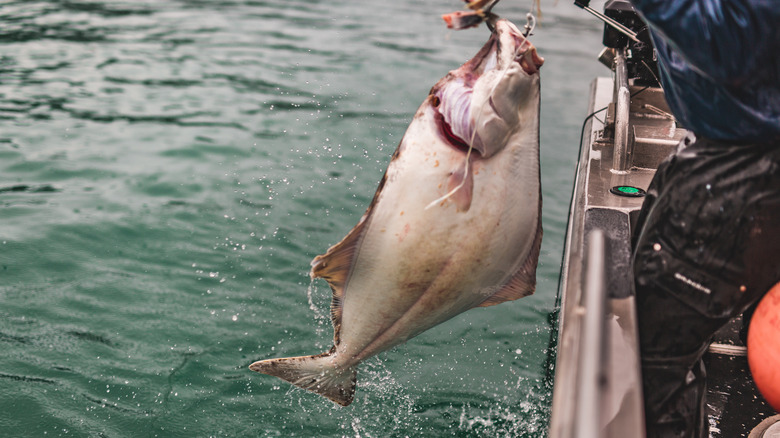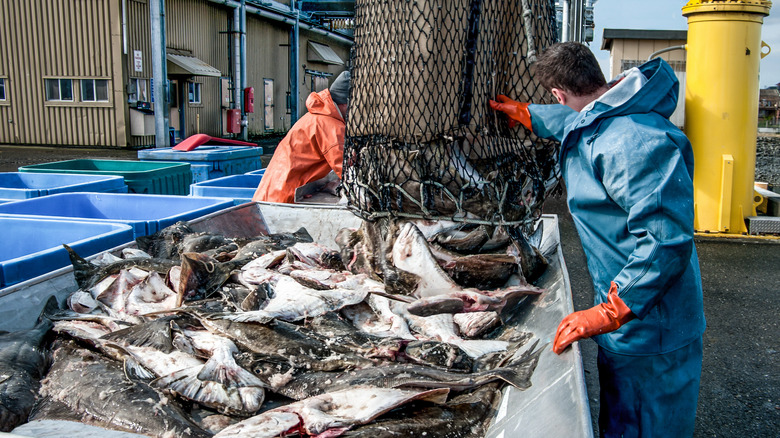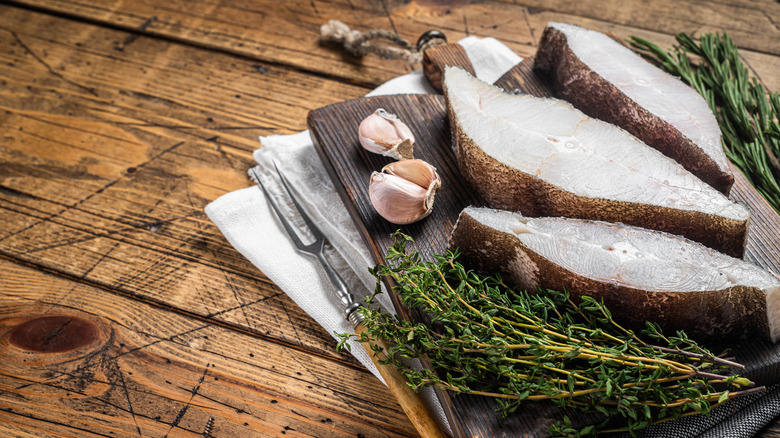What Is Halibut And Why Is It So Expensive?
Halibut has nearly doubled in price in the last 23 years, going from just under $2 a pound to over $4 for Pacific varieties of the saltwater flatfish. But why? In contrast to Atlantic halibut, Pacific halibut is not considered overfished by the National Oceanic and Atmospheric Administration (NOAA), so supply should theoretically be fine, right?
The Atlantic halibut supply, however, once widely commercially fished, is no longer allowed to be harvested except by small fisheries in Maine. This is despite the fact that Atlantic halibut was once considered the "superior" fish because of its higher fat content. Its disappearance from the market in larger quantities could be a factor in why the more prevalent Pacific halibut is seeing elevated prices and higher demand.
According to Kyle Molton, Fishery Management Specialist with NOAA Fisheries in Gloucester, Massachussetts (the home office for the Greater Atlantic Fisheries Office (GARFO) for New England and the Mid-Atlantic), Atlantic halibut is now only allowed as a bycatch, with limits imposed on how many can be kept per fishing expedition.
Sex and time
Speaking to us by phone, Kyle Molton explained that "vessels are allowed to keep one halibut per trip that is 41 inches or larger per fishing trip." Those 41 inches represent the size at which the NOAA believes the fish is sexually mature, or old enough to reproduce. He added that one small targeted fishery in Maine is the exception to the number restriction. In Maine, small-scale fishing operations have a 25-fish catch limit.
If Atlantic halibut were to be considered endangered under the American Endangered Species Act, then fishing would be completely prohibited, said Molton. As of now, the fish is only considered overfished, and though stock numbers are not "at risk," the species is "in a rebuilding plan" with a target date of 2055 for the stock to be completely rebuilt.
Why so long? Both Atlantic and Pacific halibut are huge fish, weighing up to 500 pounds in the case of the Pacific species, and a few hundred pounds more in the case of Atlantic. They also each have very long lives, living up to 50 years (Atlantic) or more (Pacific), according to the NOAA. On average, the fish take about 10 years to reach reproducing age, so any fish caught before it's at least that old means the end of future population contribution from that fish. This slow timeline affects availibility and price.
Fluctuations in size, fluctuations in price
Pacific halibut are caught for food and sport, but the number of pounds coming in fluctuates. This could be due to many factors according to the International Pacific Halibut Commission (IPHC), an American and Canadian organization that manages Pacific halibut stock. Sheer numbers of halibut depend on how many young are born, but the average size of the fish has also shifted. The IPHC says the 1920s and 1930s saw smaller fish, while they were larger from the 1960s to 1980s before shrinking again. The natural environment can also create changes in fish populations, as can fishing for sport.
First Nations and other Native tribes enjoyed halibut, and the fish is considered a healthy option, delivering just over the daily recommended dose of the antioxidant selenium and other micronutrients. Its flavor is said to be mild and sweet, not "fishy," and versatile as a lean white fish which pairs well with many flavors.
With such large fish promising multiple filets and sought-after flavor, plus changes in size due to various factors — not all of them known — and fishing restrictions meant to ensure the species' survival, it's no wonder that prices are up. New York City's Fulton Fish Market, for example, sells the Atlantic variety for more than $45 per pound. As an in-demand fish that cannot reproduce without safeguards to guarantee that the younger generations stay swimming long enough to reach maturation, pound for pound, halibut might just be worth the wait.


